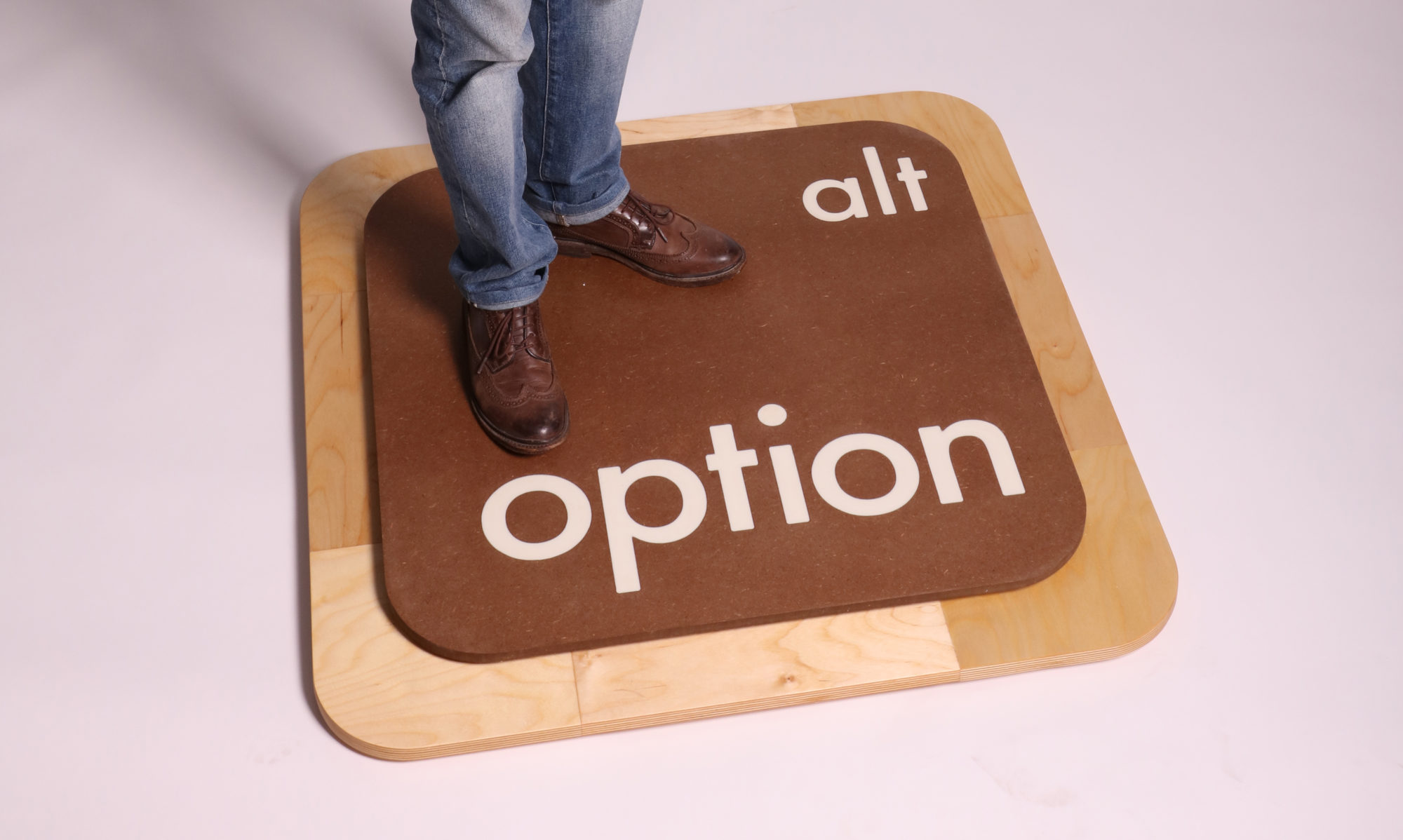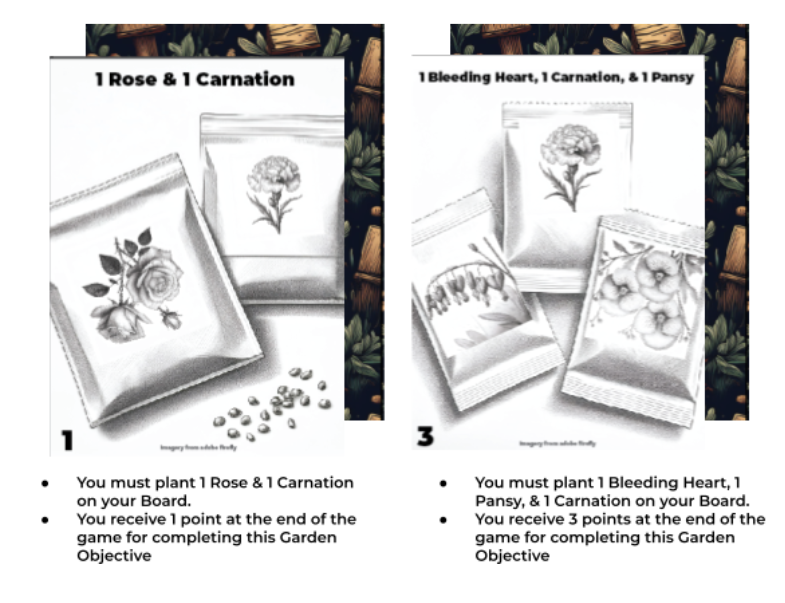Game Objective
Compete to have the best garden by planting plants and sabotaging other players with bugs.
Contents
- 50 Garden Objective Cards
- 100 Plant Cards
- 50 Bug Cards
- 10 Good Bug Cards
- 20 Bad Bug Cards
- 20 Pesticide Cards
- 1 Golden Watering Can Card
- 4 Action Reminder Cards
- 4 Garden Boards
- 1 Game Board
- Instructions
Setup
(INSERT NEW SETUP IMAGE HERE)
- Every player selects a Garden Board.
- Place the Game Board in the center of the table.
- Shuffle the Garden Objective Cards, Bug Cards, and Plant Cards. Place the decks in their respective spots on the Game Board.
- Place the Golden Watering Can Card face-down in its respective spot on the Game Board.
- Turn over the top 4 Plant Cards and place them in a face-up row next to the deck, as indicated by the spots on the Game Board.
- Turn over the top 2 Bug Cards and place them in a face-up row next to the deck, as indicated by the spots on the Game Board
- Deal 3 Plant Cards, 1 Bug Card, and 1 Garden Objective Card to each player. Players may look at their cards, but should keep them a secret from the other players.
- Give each player an Action Reminder Card.
The player who owns the most house plants (in real life) goes first. Play proceeds in a clockwise manner.
Gameplay
Points are earned by completing Garden Objective Cards, using Plant Cards. Players must plant all of the required plants on their Garden Board by laying Plant Cards on their board, face up. Some Garden Objective Cards are more difficult, and, therefore, are worth more points at the end of the game.
On Your Turn
- Perform Actions
Players perform 3 Actions on their turn. Players may perform the same Actions multiple times, and they can be performed in any order. You can quickly reference these actions at any point during the game using your Action Reminder Card. The 9 Actions include:
- Draw a Plant Card
- Plant a Plant in your Garden
- Draw a Bug Card
- Sabotage Another Player’s Garden
- Play a Good Bug Card on your Garden
- Sweep the Plant Cards
- Use Pesticide
- Draw a Garden Objective Card
- Dig Up Your Garden
- Discard a Card
Draw a Plant Card
Draw a Plant Card, either from the top of the deck or from the row of face-up cards. If you take a face-up card, replace the gap with a new card from the top of the deck. There is no limit to the number of cards a player can have in their hand.
Plant a Plant in your Garden
Place ONE Plant Card face-up on your Garden Board. Each Garden Board has two plots, Plot 1 and 2. Each plot has space for up to 3 Plant Cards.
Draw a Bug Card
Draw a Bug Card, either from the top of the deck or from the row of face-up cards. If you take a face-up card, replace the gap with a new card from the top of the deck. There is no limit to the number of cards a player can have in their hand.
Sabotage Another Player’s Garden
Place a Bad Bug Card face-up on any other player’s Garden Board on one plot. The Bug immediately eats one Plant. The affected player discards this Plant Card. The Bug will continue to eat Plants in the player’s Garden until it is killed with Pesticide. A Bug takes 1 Plant at the beginning of the affected player’s turn until exterminated. Additionally, players cannot meet Garden Objectives when a Bad Bug is in their Garden. Only 1 Bad Bug, in addition to 1 Good Bug, can be placed on a plot at a time.
Play a Good Bug on your Garden
Place a Good Bug Card face-up on your Garden Board on one plot. A Garden Objective completed with a Good Bug Card applied to it will score additional points at the end of the game. Only 1 Good Bug, in addition to the 1 Bad Bug, can be placed on a plot at a time.
Sweep the Plant Cards
If you do not like the four face-up Plant Cards, you may sweep them away to get four new ones. Discard all four cards and replace them with the top four cards from the deck. You CANNOT sweep the Bug Cards
Use Pesticide
To remove an unwanted Bad Bug from your Garden Board, you must use Pesticide. REPLACE the Bad Bug from your affected Garden Board Plot with a Pesticide Card. The Pesticide kills the Bad Bug, and the Bad Bug Card is discarded. Pesticide REMAINS on the plot until the beginning of the player’s next turn and PREVENTS another Bad Bug from being placed on the plot during that time.
Draw a Garden Objective Card
Draw a Garden Objective Card from the top of the deck. NOTE: Players can only have 2 Garden Objective Cards in their hand at a time.
Dig Up Your Garden
In the event that players don’t want the plants on their Garden Board anymore, players must remove ALL of the Plant Cards from ONE of the plots on their Garden Board.
Discard a Card
Discard 1 unwanted Plant Card, Bug Card, or Garden Objective Card from your hand. Place the card in its respective discard pile.
Completing Objectives
Objectives are completed automatically when you have met all of the requirements on a Garden Objective Card. To indicate this, lay the Garden Objective Card face-up in front of you. Requirements are met when all of the Plant and Bug Cards shown on the Garden Objective Card are placed on one Garden Board plot. All of the Bug and Plant Cards (except for the Good Bug Cards) on the plot that fulfill this requirement are discarded.
- You may complete Objective Cards anytime during your turn and it does NOT count as one of your standard Actions. It is possible to complete more than one Garden Objective Card during your turn.
- If there is a Good Bug Card applied to the Garden Plot that completes the Objective, stack this card underneath your completed Garden Objective Card in front of you.
- Garden Objectives CANNOT be completed with a Bad Bug on the Garden Plot. Bad Bugs MUST be killed with Pesticide first.
Types of Cards
There are three different types of cards throughout the game: Plant Cards, Bug Cards, and Garden Objective Cards. The following describes and provides examples of these cards.
Plant Cards
Plant Cards enable players to complete Garden Objective Cards, which are necessary to earn points and win the game. Up to 3 Plant Cards can be planted on 1 plot.
Bug Cards
There are three types of Bug Cards: Good Bug Cards, Bad Bug Cards, and Pesticide Cards.
Good Bug Cards
Good Bug Cards are white and feature bugs that will benefit your Garden.
- Only 1 Good Bug Card can be placed on a Garden Board Plot at a time.
- At the end of the game, you receive 3 additional points for every Garden Objective Card completed with a Good Bug on it.
- You CANNOT place a Good Bug Card on another player’s Garden Board.
Bad Bug Cards
Bad Bug Cards are black and feature bugs that will harm other player’s Gardens.
- When a Bad Bug Card is placed, it immediately eats 1 Plant Card. That card is then discarded.
- A Bad Bug eats 1 Plant at the beginning of the affected player’s turn until exterminated.
- Attacking Player selects which Plant Card the Bad Bug Eats.
- Only 1 Bad Bug Card can be placed on a Garden Board Plot at a time.
- You CANNOT complete Garden Objectives with a Bad Bug on your plot. Bad Bug Cards MUST be killed using Pesticide before an Objective can be completed.
- You CANNOT place a Bad Bug Card on your own Garden Board.
Pesticide Cards
Pesticide Cards are mixed throughout the Bug Cards and allow players to kill Bad Bugs placed on their Garden Board.
- To use Pesticide, lay the Pesticide Card on 1 plot of your Garden Objective Board.
- The Pesticide immediately kills the Bad Bug, and the Bad Bug Card is discarded.
- The Pesticide Card remains in the spot where the Bad Bug was on that player’s board until the beginning of the player’s next turn.
The Pesticide Card prevents other players from laying a Bad Bug on the affected player’s plot until the Pesticide Card is removed at the beginning of their next turn.
Garden Objective Cards
Garden Objective Cards are necessary to earn points and win the game. Garden Objective Cards are completed by obtaining and planting all of the required plants on the card.
Action Reminder Cards
Action Reminder Cards reference the actions that players are able to take each turn. Players should refer to the rules for the function and details of each Action.
Golden Watering Can Card
At the end of the game, the Golden Watering Can Card is awarded to the player who triggers the final round, or completes 5 Garden Objective Cards first. This card is worth additional points at the end of the game.
End of the Game
The player who reaches 5 objective cards first triggers the final round. The player who triggered the final round receives the Golden Watering Can Card. The remaining players get one last turn to try to complete objectives in order to earn points. The player with the most points tallied up from their completed objective cards wins.
- Tally the points from only the COMPLETED objective cards
- Add an extra 3 points for every Good Bug that you completed a Garden Objective with
- The player with the Golden Watering Can Card adds 2 extra points to their score






